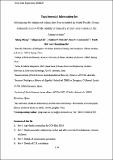Por favor, use este identificador para citar o enlazar a este item:
http://hdl.handle.net/10261/198753COMPARTIR / EXPORTAR:
 SHARE SHARE
 CORE
BASE CORE
BASE
|
|
| Visualizar otros formatos: MARC | Dublin Core | RDF | ORE | MODS | METS | DIDL | DATACITE | |

| Título: | Mechanism for enhanced eolian dust flux recorded in North Pacific Ocean sediments since 4.0 Ma: Aridity or humidity at dust source areas in the Asian interior? |
Autor: | Zhang, Qiang; Liu, Qingsong; Roberts, Andrew P.; Larrasoaña, Juan C. CSIC ORCID; Shi, Xuefa; Jin, Chunsheng | Palabras clave: | Asia Cenozoic Clastic sediments Far East Neogene North Pacific Ocean drilling program ODP Site 885 Pacific Ocean Paleoclimatology Pliocene Quaternary Sediments Tarim Basin Tertiary Weathering Xinjiang China Dust Leg 145 Marine sediments |
Fecha de publicación: | ene-2020 | Editor: | Geological Society of America | Citación: | Geology, 48(1) : 77–81 (2020) | Resumen: | Eolian material within pelagic North Pacific Ocean (NPO) sediments contains considerable information about paleoclimate evolution in Asian dust source areas. Eolian signals preserved in NPO sediments have been used as indices for enhanced Asian interior aridity. We here report a detailed eolian dust record, with chemical index of alteration (CIA) and Rb/Sr variations, for NPO sediments from Ocean Drilling Program Hole 885A over the past 4.0 m.y. CIA and Rb/Sr co-vary with the dust signal carried by combined eolian hematite and goethite concentrations. Changes in CIA around the intensification of Northern Hemisphere glaciation (iNHG) event at ca. 2.75 Ma indicate that dust production in source areas was associated mostly with physical and chemical weathering before and after the iNHG event, respectively. We here attribute the eolian flux increase into the NPO across the iNHG event mainly to increased availability of wind-erodible sediment in dust source areas derived from snow and glacial meltwater runoff, which resulted from glacial expansion and enhanced snowfall in the mountains surrounding the Tarim region in response to global cooling. Our results provide a deeper understanding of Asian interior environmental changes in response to global paleoclimate changes, where dust source areas became intermittently moister rather than more arid in response to global cooling. | Versión del editor: | https://doi-org.sire.ub.edu/10.1130/G46862.1 | URI: | http://hdl.handle.net/10261/198753 | DOI: | 10.1130/G46862.1 | ISSN: | 0091-7613 | E-ISSN: | 1943-2682 |
| Aparece en las colecciones: | (Geo3Bcn) Artículos (IGME) Artículos |
Ficheros en este ítem:
| Fichero | Descripción | Tamaño | Formato | |
|---|---|---|---|---|
| Soriano_Geology_8_1_ 77–81_2020_Suppl.inf..pdf | 710,54 kB | Adobe PDF |  Visualizar/Abrir |
CORE Recommender
SCOPUSTM
Citations
36
checked on 12-abr-2024
WEB OF SCIENCETM
Citations
32
checked on 25-feb-2024
Page view(s)
223
checked on 19-abr-2024
Download(s)
90
checked on 19-abr-2024
Google ScholarTM
Check
Altmetric
Altmetric
Este item está licenciado bajo una Licencia Creative Commons

